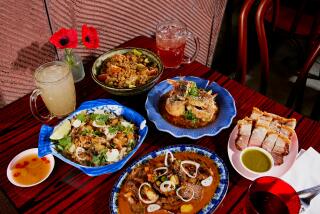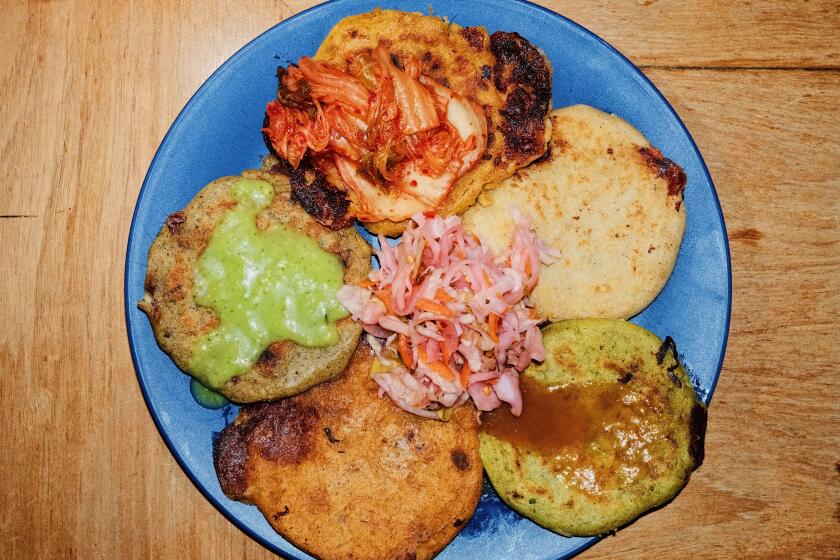Singing the Praises of a Singapore Restaurant
The variety of food tucked into one little island is amazing. I’m referring here to Singapore, where eating is the national pastime and the food is tremendously good. The trouble is, you have to go there to get it because Singaporean food has not been exported like other Asian cuisines.
Now, however, Los Angeles has a bona fide Singaporean restaurant--not a fast food shop, but a place to sit down, relax and try some really fine satay, Hainanese chicken rice, laksa and other dishes that are basic fare in the island republic.
The place is the Hollywood Palm Hotel’s Kebaya Court. Under Singaporean ownership, the hotel and its restaurant are slowly evolving into an Asian outpost. Waiters and waitresses recently donned Singaporean batiks. Oldtime photographs, antique furniture and works by contemporary Singaporean artists decorate the premises. And in May, Chef Lim Wong arrived to give pointers on menu and recipes.
Born in Ipoh, Malaysia, Wong is an expert in Straits Chinese food, an intricate cuisine that blends Chinese and Malay influences with overtones of India, Portugal and the British colonials. This food flourished along the Malay Peninsula in the old Straits settlements of Penang, Malacca and Singapore.
One of Wong’s ideas was to compose a sampler plate--actually a banana-leaf lined tray--that included tastes of several dishes. This concept was so well-received that it is now available upon request and is a handy escape from the formidable task of choosing a meal from unfamiliar items.
Of course, virtually everyone knows satay and should be happy with the version here. The accompanying peanut sauce is as good as any I have tasted in Singapore--so good that one of my companions scraped the sides of the bowl with a spoon, then wiped out the remnants with a lettuce leaf.
Wong also does something wonderful with pomfret, frying the fish until slightly crisp, then topping it with a crunchy, sweet, turmeric and ginger relish. Beef rendang, impregnated with coconut and spices, is excellent. Chicken rice, a great dish that ought to be better known, originated with the Chinese who migrated to Singapore from Hainan island. The components are gently poached chicken meat, rice that is sauteed in chicken fat, then cooked in the poaching broth; a bowl of the broth and a trio of dipping sauces: black sweet soy sauce, a ginger dip and another based on red chiles (red sweet peppers and jalapenos in Wong’s adaptation).
In most dishes, Wong, who is Hainanese, keeps spicy heat to a modest level. As in the chile dip, he often combines chiles with sweet red pepper, which supplies brilliant color without searing the taste buds. But the food can be as hot as you like.
When I wanted zestier flavor in a bowl of Penang-style curry laksa, the kitchen sent out a hot red chile paste that provided plenty of zip. Laksa is a brothy mixture of coconut milk, rice noodles and bean sprouts with shrimp, tofu and hard-cooked egg adding lots of substance.
There are alterations in some dishes. The curried meat for murtabak is stuffed into a spring roll skin rather than the resilient dough that Indian cooks in Singapore stretch to thinness on marble slabs. But it’s a good appetizer anyway.
Although not extensive, the menu covers a fair range of food. The best dessert is coconut delight, a pretty combination of melon balls and young coconut meat topped with shaved ice, splashed with rose syrup and decorated with a parasol.
There was some debate over a proper name for the restaurant. The word kebaya, which won out, has an exotically sinuous sound, like palm fronds swaying on a tropical island. A kebaya is, in fact, the filmy, embroidered top that Straits Chinese women wear with their sarongs.
Kebaya Court Restaurant, 2005 N . Highland Ave., Los Angeles, in the Hollywood Palm Hotel. (213) 850-5811. Open daily. Hours are from 6 a.m. to 2 p.m. and from 6 to 11 p.m. All major credit cards accepted. Free parking in the hotel lot. Entrees from $6 to $8.
More to Read
Eat your way across L.A.
Get our weekly Tasting Notes newsletter for reviews, news and more.
You may occasionally receive promotional content from the Los Angeles Times.










